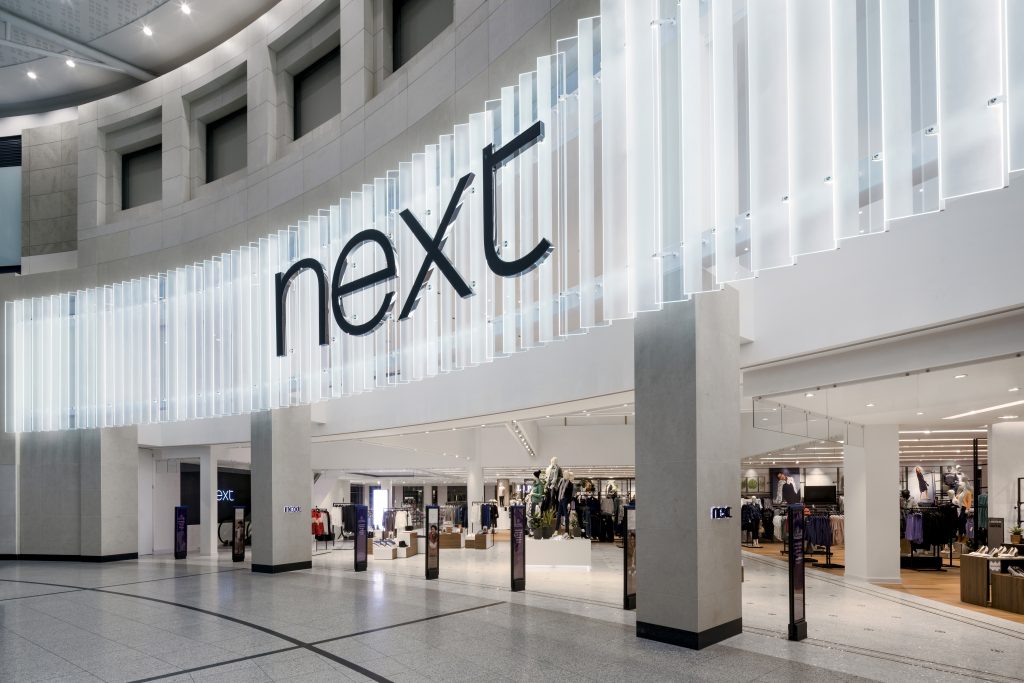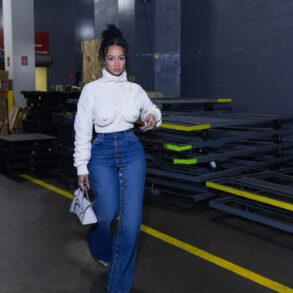
Against a backdrop of rising inflation, the cost of living crisis and unseasonably warm weather, the recent financial reports from fashion retailers are a mixed bag.
This month, Very Group reported a 8.2% decline in fashion and sportswear for the for the 52 weeks to 1 July 2023. This week Sainsbury’s Tu clothing reported an 8.4% drop in clothing sales for the 28 weeks to 16 September. Etailer Asos is curtailing its losses, as its full year results published this week showed a 10% decline in group revenue and a 238.7% increase in operating losses to £248.5m, and is rumored to be dropping Topshop imminently to cut costs.
However, high street giant Next is seemingly bucking the sector’s downward trend. Fullprice sales for the three months to 28 October increased by 4%, leading the retailer to increase its full year guidance for profit before tax by £10m to £885m.
Next has been on an acquisition spree. It added British lifestyle retailer FatFace to its ever-growing portfolio in October, buying the business for £115.2m. In September it also upped its stake in Reiss to 72%. Other notable buys include the IP of Cath Kidston in March for £8.5m, 74% of Joules in December 2022 for £34m, Made.com’s IP in November 2022 for £3.4m and Jojo Maman Bébé for £16.3m in April 2022.
Industry experts tell Drapers the key lessons retailers can learn from Next, and whether it is possible to bottle the fashion retail lightning driving the business.
Advertisement
1. Move with the times
Despite offering consumers a broad mix of brands and styles, which provides customers with options for every occasion at a range of price points, Next’s strength lies in its staying power, according to Aoife Byrne, senior fashion and retail analyst at market data platform Edited.
“Next has been stalwart on the high street for many years,” said Byrne, highlighting that despite being founded in 1864, Next manages to remain current.
“Next has been a brand they [customers] can count on throughout the years. Furthermore, Next has been working hard to secure its newly-acquired/future customer by partnering with targeted influencers and content creators who appeal not only to Gen X but also to Millennials. These younger tastemakers include [fashion broadcaster at Sheer Luxe and content creator] Polly Sayer and [former Made In Chelsea reality TV star and personality] Georgia Toffolo.”
Both Toffolo and Sayer routinely promote Next’s products to fans and followers on their Instagram pages, and also curate wish lists of products on Next’s website.
2. Take risks with diversification
Having very recently acquired FatFace, the retailer also upped its stake in Reiss to 72% in September this year as part of a strategic partnership. This meant that Next customers would have access to a broader range of fashion at different price points, and independent consultant Maureen Hilton highlighted that its product offering means it resonates most with a specific type of audience.
“Its customer base tends to be families so it targets what products are necessary for customers at that stage in life,” said Hilton.
Advertisement
She added, however, that it would be remiss to say that Next only appeals to customers with a family as it is constantly having to innovate its own ranges, inspire customers but also be mindful of their budgetary constraints:
“It sounds a bit too safe to say they appeal to one particular market because they do have to think of how they can innovate from their own ranges. They can’t play safe so they’re trying to inspire their customers but also understand what their budgetary constraints are.”
And when it comes to playing it safe, Hilton said this is something Next had been guilty of “some years ago”, but now it is more keen on taking “managed risk” with its acquisitions.
She said Next’s CEO Simon Wolfson, who has been at the helm since 2001, “made a point of not taking [overt] risks with buying into other brands, because the brands all have their own appeal to its customer base, and it diversifies the range of their offering”.
Indeed, this was highlighted in Next’s latest full year trading results for the 12 months to 31 January 2023, which stated that its product teams continued to “push the boundaries of their offers in terms of design content, price architecture and product categories”.
Meanwhile, Byrne highlighted that Next’s range of womenswear, menswear, childrenswear and homeware is also appealing to customers during the economic downturn, as it has become a “one-stop-shop” for women buying for themselves, their family and their home: “ [It is] helping to boost basket spend and reduce delivery costs for the customer during the cost-of-living crisis.”
3. Invest in online platforms
The retailer, which was an early pioneer of direct selling as a catalogue business, has effectively applied this instinct for innovation to the digital space, another retail expert told Drapers.
Next broke into the world of online sales in 1999 and then in 2020 it launched its Total Platform – which is used by the brands it owns and others, both of which are “phenomenal” according to Jonathan De Mello, founder and CEO of retail and property consulting firm JDM Retail.
“It’s a very strong transactional website and one of the first, most successful examples of an online business that we’ve had from [a retailer that] started out as a physical [store] going online. They get the physical and online and seamlessly blend the channels to benefit the consumer,” he said.
This all boils down to Next’s investment in its digital platform, explained Mathew Dixon, partner at executive search and leadership consultancy DHR Global, who said the retailer did this “heavily and intelligently” before the pandemic and was leveraging online sales while the rest of the market was “scrambling” to keep up.
“Their online UX [user experience] is very good and logistically they are excellent; deliveries are quick, on-time and reliable, whilst returns are simple, whether via post or in-store, it is a seamless and painless experience. They have one of the highest percentages of online customers over the age of 60, which shows how straightforward their online offer is to use,” said Dixon.
4. Audit your management approach
Hilton praised Wolfson and his team on having a “good handle” on what is happening throughout the business, and running Next in a way that means it is constantly evolving – both externally and internally.
“They [Next’s directors] have developed a strong culture across the business that gives people authority to act and innovate with support, so it’s not just all top down,” said Hilton.
Wolfson has spoken at length about his leadership style in the past: “Colleagues do not need permission to take decisions, taking sensible decisions is a requirement of their job.”
De Mello also praised Nexts’ leadership under Wolfson for its consitency and steadiness. “They’ve had the same leadership structure for the last couple of decades now with Wolfson at the helm and he’s very good at managing expectations,” said De Mello. “They always beat their expected results because they always temper what people expect.”
Dixon also applauded the leadership team, which has made Next an “incredibly stable” business. “Long term sustainable growth has meant the leadership team has largely grown from within and remains consistent,” said Dixon.
“It is rare to see directors leave and that stability shows through the consistency of their operations. However, unlike other retailers with highly tenured teams, the desire to innovate has remained at the forefront in what they deliver.”
5. Develop a clear acquisition strategy
Having acquired both FatFace in October and Cath Kidson in March, Wolfson said in September that the retailer would not become a “corporate blob” as it has a clear criteria for investment and maintains the independence of its acquired brands. For example, under the terms of its acquisition, FatFace will retain its management autonomy and creative independence and continue to be based in Havant, Hampshire.
Next has a sharp brand acquisition strategy, which looks to take advantage of the uncertain retail climate while being “inquisitive” to bring in new offerings and expand its platform, explained Tamara Sender Ceron, associate director – fashion retail at research agency Mintel.
“It is very selective with the companies it chooses, and for example FatFace is a well performing brand rather than a struggling business,” said Ceron. “Obviously it got into financial difficulty… but [it] complements Next’s offering.”
Ceron said the acquisition of FatFace and increasing its stake in Reiss [September 2023] was a “savvy move” that is more like a partnership, as with every acquisition Next makes, it will benefit both parties “as opposed to taking on a failing brand and stripping it down”.
She added: “In the current climate we’ve seen Next and a lot of other businesses looking to expand their price architecture to include value and premium brands. It’s a clever move.”
On this, Dixon said: “They are equally able to reboot a faltering business like Made or Joules or amplify the likes of a Reiss or FatFace to new levels. They instinctively know which brands will add value to their portfolio and likewise are also often considered a preferred bidder due to the way they operate and conduct themselves.”
While the sector praises Next, experts also said there are challenges on the horizon, as scaled-back Christmas sales during the ongoing cost of living crisis could put a dent in its financial results. But broadly speaking, the industry tells Drapers that Next is at the vanguard of British high street fashion – and there are plenty of lessons to be taken from its success.
This post was originally published on this site be sure to check out more of their content.







